12″ Vinyl only
Photography by Geir Jenssen & Emilija Skarnulyte
Design by Jon Wozencroft
Cut by Jason at Transition
Field recordings of a volcano by Geir Jenssen, better known as Biosphere.
Stromboli is an active volcano off the north coast of Sicily in the Mediterranean. The volcano has erupted many times, and is constantly active with minor eruptions, often visible from many points on the island and from the surrounding sea, giving rise to the island’s nickname “Lighthouse of the Mediterranean”. The last major eruption was on April 13, 2009.
Track listing:
Side A Stromboli 9:40
Side B Stromboli Dub 9:36
Recorded at Stromboli’s crater edge (924 m) on July 19th 2012 at 9:30 pm.
Weather: gentle breeze, +15°C.
Location: 38°47’33.69″N, 15°12’50.96″E
Recording equipment: Fostex FR-2LE field memory recorder, Audio-Technica AT835ST shotgun microphone, and a Canon 5D mkII SLR.
Reviews:
The Sound Projector (UK):
I first sought out Geir Jenssen’s work in 2005 after a short tour around the UK, when Biosphere’s output was strongly recommended at 3am, after a concert in someone’s basement in Salford, by a man wearing a t-shirt that stated, simply, “Listen To Grindcore”. Obviously, as you can probably guess, it was the t-shirt that made me take him seriously. He challenged me, sloshing his tin of lager about in the air for added emphasis while staring vengefully through whatever stimulants were keeping him awake, equally simply but also somewhat more emphatically and deadly serious, to “listen to Biosphere”. So, not having come across the name before, when I got back home, I did.
And I’m mostly glad I did. I’m not really that interested in the early techno stuff, but for sheer sonic depth and immersive cold ambience, Geir Jenssen is quite rightly considered the man to go to, and his curriculum vitae will back this up.
With this release, Jenssen leaves behind the massive clubs and outdoor events, the advertising commissions and jet-set lifestyle of the techno producer and enters the world of the field recordist – he leaves behind the Nike Airs and v-neck t-shirts and puts on his stout trainers, cargo pants and fisherman’s waistcoat. These items are particularly favoured by field recordists with their handy pockets for wind shields, battery packs, adaptors, Kendall Mint Cake and other necessaries for extended periods out of doors. Jenssen is now forever lugging around the signature fluffy-baffled shotgun microphone over one shoulder with a matching portable multi-track hard drive recorder over the other. You get the idea. On Stromboli, as well as the opportunity to imagine Jenssen additionally possibly donning a heat-suit, we get to hear the hissings, explosions, and the pattering of falling rock of Stromboli, an active volcano in Italy, and presumably also the sounds made by 700° C lava creeping languidly around his feet.
Stromboli itself is of sufficient importance with Volcanologists to warrant a volcanic phenomenon being named after it. So called Strombolian eruptions are volcanic eruptions which can send incandescent cinder and lava bombs into the air to heights of up to hundreds of metres.
As Biosphere, Jenssen has worked with field recordings before, notably on Outside By The Fjord and Cho Oyu 8201m – Field Recordings From Tibet. And as a mountaineer in his spare time, (he scaled the Himalayan peak Cho Oyu in 2001), I’m sure he was able to get himself into some good spots on the volcano to record. It is interesting that he has chosen another, not unperilous, environment to work in, what with flowing lava and hot flung debris. Although how near he actually had to get to the crater itself to capture these noises is not clear – some sounds seem distant while others I’m sure are worryingly close. The record sleeve states that the recordings were made “…at Stromboli’s crater edge (924m)” but that would certainly be 923m too close for me.
In terms of Jenssen’s previously released field recordings, Outside By The Fjord is a film documenting a field recording excursion in Sørfjorden, near Tromsø, Norway commissioned by Fondazione Musica per Roma in 2008 and Cho Oyu 8201m – Field Recordings From Tibet was a collection of recordings made during his climb which were destined for use in the making of Dropsonde.
So what was the intention? Simple documentation at first seems the most likely being as they are a quite dry although undoubtably courageous documentation of a dangerous natural phenomena. Unlike other practitioners such as David Velez, Simon Whetham, Mecha/Orga, Jez riley French, Angus Carlyle, Peter Cusack or Lasse-Marc Riek, there is no sense of a journey, narrative or transition or sense that the artist has attempted to create something other than what simply meets the ear. Even the nature-obsessed Chris Watson’s work relies heavily on a sense of editing clarity and compositional brevity. Stromboli for all the excitement of the subject matter, suffers, perhaps, for its authors lack of commitment toward the material’s presentation. Or maybe that is the point – in releasing a straight field recording under his own name, Jenssen is deliberately disassociating himself from the lush productions of the Biosphere entity. Alternatively, Stromboli could have been a showcase for Jenssen’s location recording skills. Is he casting about for work in television for natural history or geography documentaries? Perhaps the National Geographic Channel aren’t hiring at the moment.
The percussive nature of the explosions of the volcano put me in mind of 17th Century ships’ cannon. The hissing and fizzing noises could also be mistaken for the sound of rolling waves out at sea. I wonder if there is a maritime connection in Jenssen’s mind? Maybe if you played this album over a film of period ships, (or even Pirates of the Caribbean), would it fool the brain? It also put me in mind of the sounds that emanate from all that Ministry of Defence land in Dorset near where I grew up, where the Army practice manoeuvres with live rounds.
In a way, travel is bound up inextricably with field recording practice – searching out the unusual, alien, exotic, unheard. Jenssen officially joins the ranks of these sonic H V Mortons in search of something else; and I’m keen to hear where his next postcard hails from.
Quite a curious prospect this, then. The sleeve offers up photographs taken at night; on the cover the volcano itself, on the reverse Geir Jenssen manipulating his equipment. Couple this with the malevolent nature of the audio and I’d say this is a good record to put on to augment the sounds of Bonfire Night next November.
whisperinandhollerin’ (UK):
So how many of us have actually stood on the edge of the crater of an active volcano? Like me, you’ve probably seen eruptions on TV and marvelled at the force of nature in terms of the visuals, but not paid so much attention to the sounds. Geir Jenssen, who usually records under the Biosphere moniker, lugged his field recording kit to the edge of the abyss of the perennially active Stromboli volcano off the north coast of Sicily, and this is his report back.
It’s impressive, that’s for sure. It rumbles, it thunders, it roars. The ‘dub’ version on the flipside adds delay to the immense crashes and subterranean grumbles. Sounds comparable to a terrifyingly high tide or a violent storm and explosions blast from the grooves of this vinyl-only release, and it makes you stop and think.
As a record, it’s so-so, in that it isn’t exactly every day listening, but as a soundtrack, background work and source of samples, not to mention a source of contemplation, it’s impressive.
Record Collector (UK):
Recorded at the crater’s edge of the Stromboli volcano, 924m above sea level, on 12 July 2012, GEIR JENSSEN (aka BIOSPHERE) aimes a Fostex FR-2LE field memory recorder at the beast and hung on for dear life while creating Stromboli (**** Touch). The “music” is dynamic to say the least. Unsettling and unpredictable, it will test the dynamic capabilities of your hifi, skimming the upper mids in a jet-like soar to sub-bass explosions that keep tension high. Location atmospherics demand that sound quality doesn’t reach audiophile levels, but it’s a roller coaster ride. [Spencer Grady]
Experimedia (net):
No longer standing behind a pseudonym, Geir Jenssen, better known as Biosphere, also does away with much of the electronic treatments and digital manipulations that have made him a standout artist on Touch Music. The album’s title, “Stromboli,” is taken from the name of a volcano off the north coast of Sicily and Jenssen documents its simmering movements and random outbursts of activity for the duration of the record. The rustling organic textures could easily be lapping waves or swirling leaves, but the threat of sticking a microphone into a still active volcano does add a certain sense of danger to the proceedings as well as a thick layer of intrigue to the listening experience. [Ryan Potts]
Record Collector (UK):
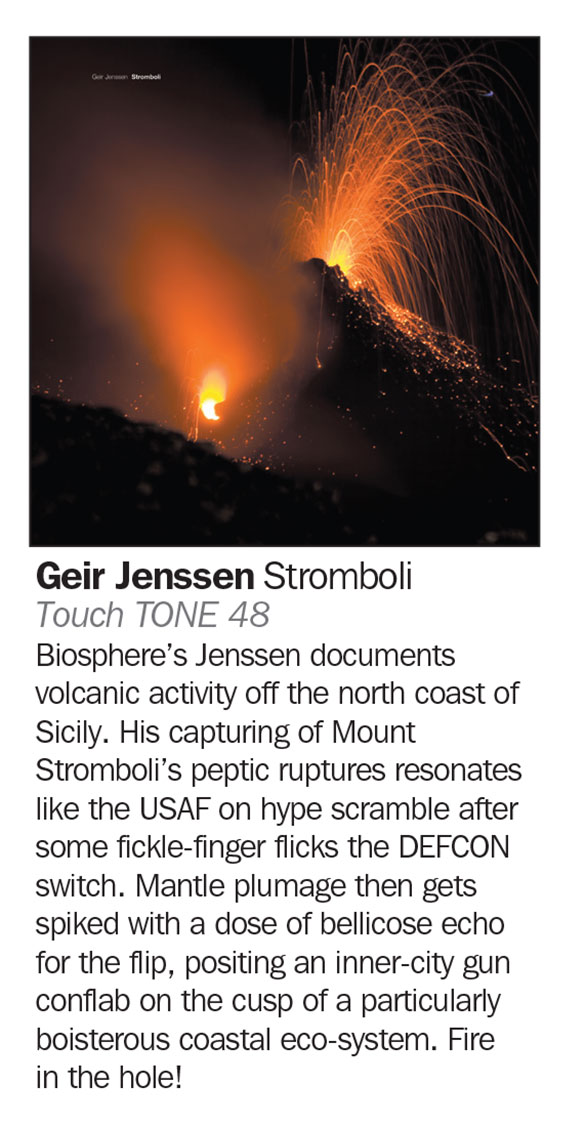
Rockerilla (Italy):
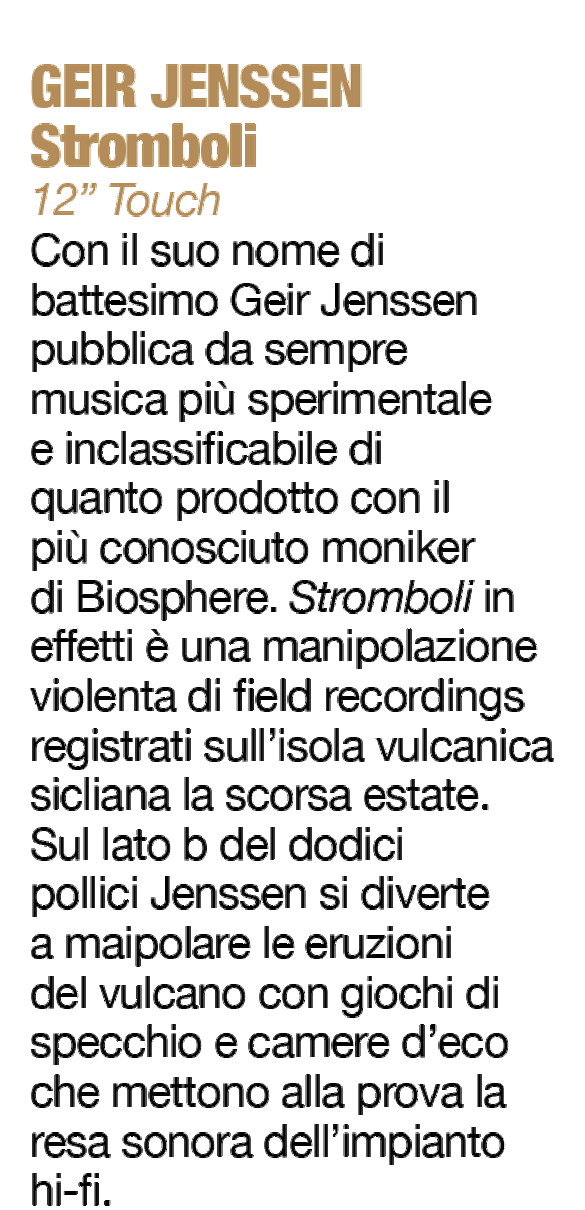
The Wire (UK):
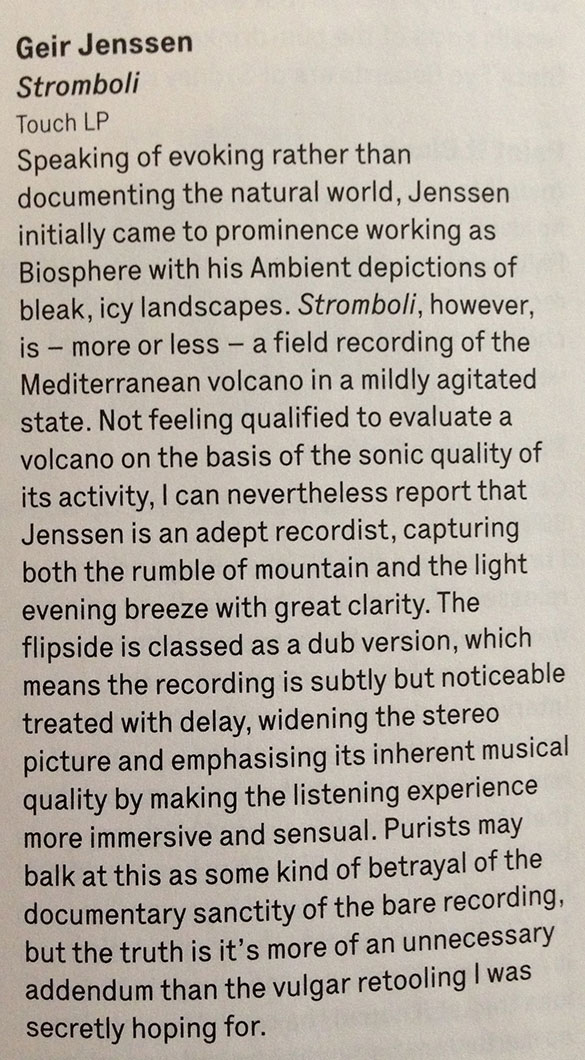
debug (Germany):
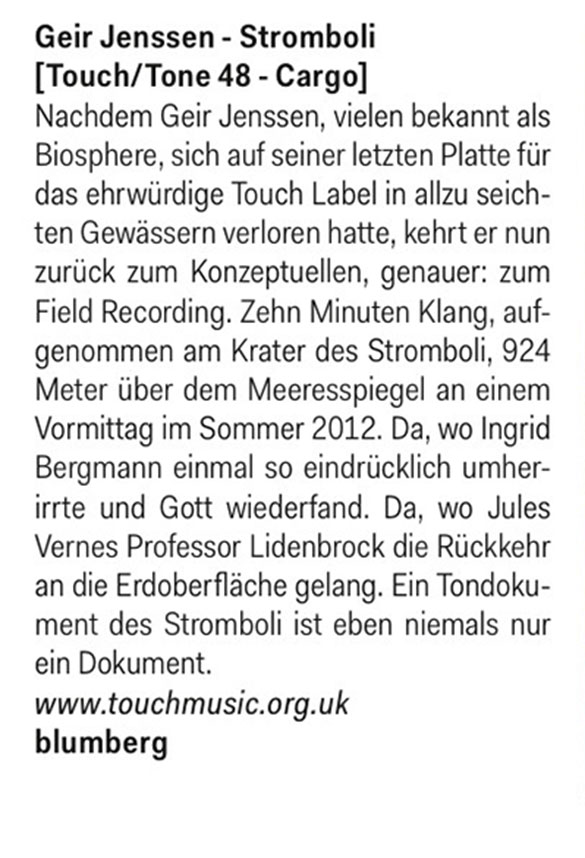
dMute (France):
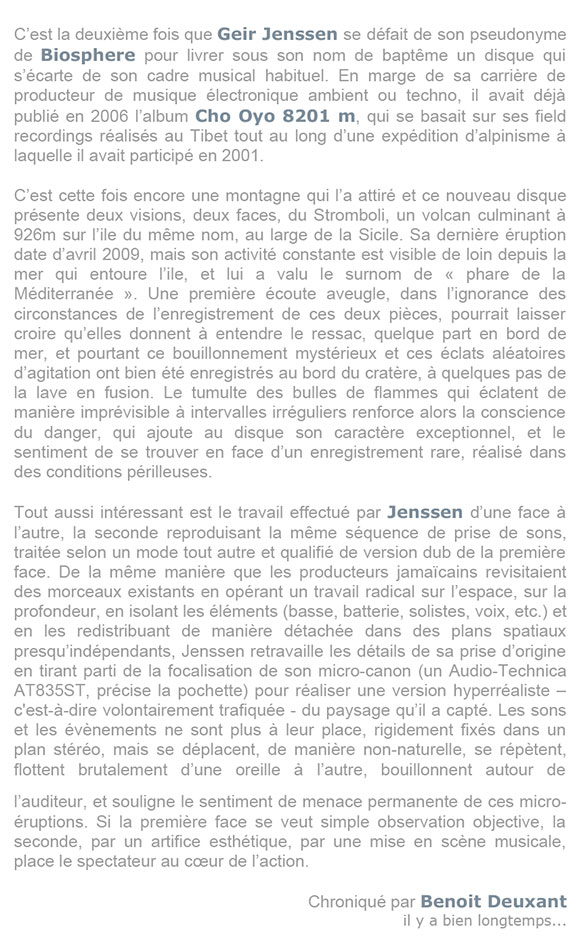
Black (Germany):
Sich auf eine Insel begeben, den dort befindlichen Vulkan aufsuchen, die Sounds des stetig rumorenden Ungetüms aufzeichnen und anschließend überarbeiten – so könnte die Kurzbeschreibung der jüngsten Geir Jenssen-Veröffentlichung lauten. Nach Stromboli zum Stromboli also. Die Arbeiten des in Tromsø Heimischen durchzieht ein auch aktuell vorliegender konzeptioneller Ansatz. Geir bestieg dafür vor ca. einem Jahr den 924 Meter hohen Feuerspuckschlot, brachte Kontaktmikrophone an und zeichnete fleißig auf.
Im Ergebnis liegt nun eine 12“ vor, die jeweils einen Track pro Seite trägt. Die Herangehensweise vieler Arbeiten des Norwegers zeichnet sich dadurch aus, dass der Idee eine intensive Beschäftigung folgt. So war es (als BIOSPHERE) bei “Cirque“ die Geschichte von Christopher McCandless, der später von Sean Penns wunderen Verfilmung “Into The Wild“ ein Parallelkunstwerk zur Seite gestellt wurde. Oder bei den Fieldrecordings aus Tibet auf “Cho Oyu 8201 m“ – hier allerdings unter seinem bürgerlichen Namen veröffentlicht. Oder, oder, oder. Eine Geschichte respektive ein Naturphänomen als Ausgangspunkt einer Ambientveröffentlichung – hier hat der 1962 Geborene tiefe Spuren hinterlassen und nicht wenige andere Projekte inspiriert. Wenn also der Einfluss eines Künstlers so prägend ist, werden bei jeder neuen Veröffentlichung große Erwartungen geweckt. Auf “Stromboli“ weiß er diese wieder einmal zu befriedigen.
In Miniatureruptionen hinein platzen Kleindonnereien, jedoch nie als wuchtige Schläge, sondern vielmehr entlang eines wabernden Zischelns und Knackens. Dumpf grollt der Schlot und kocht und brutzelt. Die Fieldrecordings dieser von einem phänomenologischen Ansatz getragenen Platte wirken auch nach Jenssens Bearbeitung ursprünglich und weisen zugleich eine ungeheure Dehnbarkeit auf. Dabei drängelt und drängt nichts in den Vordergrund, vielmehr wird der Hörer Zeuge eines dauersphärischen, suggestiven akustischen Abbilds des vulkanischen Tremors. Die oberflächennahen Temperaturerhöhungen, die seismischen Aktivitäten und eben das niedrig frequente Beben liefern den Subtext.
Ausgeworfenes Vulkanmaterial fällt schmatzend zurück in den Krater, während Glutwölkchen emporsteigen und die umgebende Landschaft in den gewohnten Klang des Grolls taucht. Zitatfetzen aus der Wirklichkeit sind in eine Dynamik eingebettet, die mit der der Veröffentlichung zugrundeliegenden Statik fein ausbalanciert ist. Mit “Stromboli (Dub)“ findet sich die Betitelung des zweiten Tracks, bei der Hall und Echo dezent in die Fieldrecordings eingetupft wurden. Hier entfernt sich der Gesamtsound ein Stück weit vom ersten Track, die Tiefen blubbern und Klangfarbe und Tonfall deuten stärker auf die Muster der Überarbeitung hin. Akustische Stimmungsbilder die der Ursprünglichkeit und dem Mächtigen der bereisten Landschaft entsprechen, weisen auf einen Musiker hin, der nicht auf dem Gleis des Esoterischen reist. Seine kompositorischen Ideen und Eingriffe in das Ursprungsmaterial sind dezent und dennoch prägend.
Das abermals von Jon Wozencroft verantwortete Artwork rundet eine Veröffentlichung visuell ab, bei der ein ganzheitlicher Ansatz nicht Zufall, sondern Programm ist. So verzichtet Jenssen auf eine naheliegende Mystifizierung der Natur. Er führt vielmehr seine Untersuchung vor Ort in eine Nachbildung über, die seiner Ton- und Bildaffinität für die “Architektur der Natur“ entspricht. Hier schöpft jemand das Organische durch Technik neu, hier malt jemand mit Tönen.
Die Besonderheit bei all dem findet sich in der Fertigkeit des Norwegers, die natürlichen Sounds in den Überarbeitungen herauszukristallisieren. Dabei lässt er zu, dass in den Flächen die Stille und die Aufladung mitklingen. Die Soundbreite “Stromboli(s)“ gibt Zeugnis davon, welch mannigfaltige Empfindungen Geir beschlichen haben müssen, als er am Kraterrand aufzeichnete und filmte, das Mäandern von leichten inneren Beben seiner Selbst ins Verhältnis des Durchrauschten und durchkrachten Gesangs des Kraters setzte – und entlang des Durchlaufs wird sich wohl im ein oder anderen Hörer ein weiteres Nachbeben zeigen. (S.L.)
kindamuzik (Netherlands):
Een squadron straaljagers dat hoog door de lucht jaagt maar vreemd genoeg niet dicht(er)bij wil komen; een donderslag bij kraakheldere hemel, met vapor trails doortrokken blauw… Als je niet beter zou weten, gingen de gedachten bij de nieuwe 12″ van Geir Jensen (ook bekend onder zijn artiestennaam Biosphere) onwillekeurig daarnaar uit. Het is dat de titel, hoesfoto en opname-informatie van Stromboli overduidelijk tonen dat het hier gaat om het geluid van de Italiaanse vulkaan.
Dik drie jaar na de laatste grote uitbarsting beklom Jensen de krater. Op het randje op een hoogte van 924 meter, richtte hij bij een zacht briesje en zo’n 15 graden Celsius zijn microfoons de vulkaan in. De Stromboli staat ook wel bekend als De Vuurtoren van de Middellandse Zee, want eens in de zoveel tijd zijn kleine erupties prima zichtbaar. Zo wild deed de actieve vulkaan niet toen Jensen er was.
Beneden Jensen borrelde en kolkte het echter dat het een aard heeft, zo blijkt in de bijna tien minuten die de opname duurt. Je hoort vanuit het binnenste van de aarde lava opgestuwd worden en pruttelen. Intrigerend is dat het geluid onwillekeurig een zekere mate van angst inboezemt, geholpen door een basaal gevoel van onveiligheid ten overstaan van deze soort natuurgeweld.
Op de B-kant neemt Jensen de veldopnames onder handen. Zijn bewerking (getiteld: Dub) levert een ietwat meer gestructureerde luisterervaring op die op een beklemmende manier een beetje meer desoriëntatie oplevert. Stromboli past glansrijk binnen de catalogus van Touch (waar je ook veldopname-uitgaven van bijvoorbeeld Chris Watson en Mike Harding kunt vinden) en laat horen waar Geir Jensen zijn bronmateriaal vandaan haalt. Immers: ook als Biosphere werkt hij veelal vanuit fieldrecordings als basisbouwstenen. Dit ongekend of zelden gehoorde geluid is ook daarom een ware Fundgrube en de vraag is of Jensen onder zijn alter ego hiermee aan de slag gaat. [Sven Schlijper]
dMute (France):
C’est la deuxième fois que Geir Jenssen se défait de son pseudonyme de Biosphere pour livrer sous son nom de baptême un disque qui s’écarte de son cadre musical habituel. En marge de sa carrière de producteur de musique électronique ambient ou techno, il avait déjà publié en 2006 l’album Cho Oyo 8201 m, qui se basait sur ses field recordings réalisés au Tibet tout au long d’une expédition d’alpinisme à laquelle il avait participé en 2001.
C’est cette fois encore une montagne qui l’a attiré et ce nouveau disque présente deux visions, deux faces, du Stromboli, un volcan culminant à 926 mètres sur l’ile du même nom, au large de la Sicile. Sa dernière éruption date d’avril 2009, mais son activité constante est visible de loin depuis la mer qui entoure l’ile, et lui a valu le surnom de « phare de la Méditerranée ». Une première écoute aveugle, dans l’ignorance des circonstances de l’enregistrement de ces deux pièces, pourrait laisser croire qu’elles donnent à entendre le ressac, quelque part en bord de mer, et pourtant ce bouillonnement mystérieux et ces éclats aléatoires d’agitation ont bien été enregistrés au bord du cratère, à quelques pas de la lave en fusion. Le tumulte des bulles de flammes qui éclatent de manière imprévisible à intervalles irréguliers renforce alors la conscience du danger, qui ajoute au disque son caractère exceptionnel, et le sentiment de se trouver en face d’un enregistrement rare, réalisé dans des conditions périlleuses.
Tout aussi intéressant est le travail effectué par Jenssen d’une face à l’autre, la seconde reproduisant la même séquence de prise de sons, traitée selon un mode tout autre et qualifié de version dub de la première face. De la même manière que les producteurs jamaïcains revisitaient des morceaux existants en opérant un travail radical sur l’espace, sur la profondeur, en isolant les éléments (basse, batterie, solistes, voix, etc.) et en les redistribuant de manière détachée dans des plans spatiaux presqu’indépendants, Jenssen retravaille les détails de sa prise d’origine en tirant parti de la focalisation de son micro-canon (un Audio-Technica AT835ST, précise la pochette) pour réaliser une version hyperréaliste – c’est-à-dire volontairement trafiquée – du paysage qu’il a capté. Les sons et les évènements ne sont plus à leur place, rigidement fixés dans un plan stéréo, mais se déplacent, de manière non-naturelle, se répètent, flottent brutalement d’une oreille à l’autre, bouillonnent autour de l’auditeur, et souligne le sentiment de menace permanente de ces micro-éruptions. Si la première face se veut simple observation objective, la seconde, par un artifice esthétique, par une mise en scène musicale, place le spectateur au cœur de l’action. [Benoit Deuxant]
hhv (Germany):
Vertreter der These, das Herkunftsland des Komponisten spiegele sich im Klang seiner Musik, dürfte bei Geir Jenssen ausreichend diese Idee belegendes Material finden. Der Norweger kommt aus Tromsø, einer der nördlichsten Städte der Welt und seine seit 1984 unter dem Pseudonym Biosphere veröffentlichten Stücke rufen Bilder dieses weiten, schneebedeckten, rauen, stets dämmernden und gleichzeitig wunderschönen Landes hervor. Die Tatsache, dass Geir Jenssen auch Fotograf ist, scheint diese visuelle Seite seiner Musik noch zu befeuern. Unter seinem eigenen Namen veröffentlicht er Field Recordings, aufgenommen an Plätzen außerhalb seiner Heimat. »Cho Oyu 8201m« aus dem Jahre 2006 zeigte so Aufnahmen seines Trips in die türkise Bergwelt des Himalaya. Für seine neueste Veröffentlichung zog es den Norweger mit seinem Fostex FR-2LE Field Memory Recorder im Juli letzten Jahres an den Kraterrand des Stromboli. Die leichten Eruptionen des aktiven Vulkans werden hier strukturgebend. Die A-Seite lässt sie unbearbeitet, die B-Seite zeigt sie als Dub. Die Unterschiede sind nur minimal.
»Stromboli« ist eine Lektion im Zuhören. Das Magma fließt, die Gesteine schmelzen, man hört den 924 Meter hohen Berg leben. Als Musiker wird Geir Jenssen dem Fotografen ein wenig ähnlicher; er bildet die Schönheit der Natur (wie als Biosphere) nicht mehr nach, nein, er bildet sie ab. »Stromboli« gehört somit eher in eine Bibliothek als in ein Museum.
kultblog.hu (Hungary):
Az, hogy mit tekintünk zenének, relatív. John Cage és progresszív gondolkodású követői a csendet, illetve a környezeti zajokat is épp olyan zenének tekintették, mint a hangszeres játékot. Ez formabontó irányzat volt egykor, ma azonban már szinte lehetetlen újat mutatni benne.
Persze rögtön felmerül a kérdés: miért kéne újat mutatni? Nem pont az újrahasznosításról szól ma minden? Mégis, egy olyan, fokozottan kísérleti jellegű zenénél, mint a field recording, szinte állandó érvényű az újítás, a továbblépés követelménye. A hallgatótábor eleve nagyon kicsi, és még az a kevés ember sem kifejezetten szórakozás céljából tesz fel a háttérbe szólni egy jó kis felvételt a tektonikus mozgásokról. Intellektuális zene tehát a környezeti hangfelvétel, és nehéz benne igazán maradandót alkotni.
A Biosphere néven ismert Geir Jenssen 97-es ambient lemeze, a kultikus Substrata óta abban a státuszban van, hogy szinte bármit megengedhet magának. Meg is enged: a sötétebb hangvételű tundra-kalandozások mellett készített már Debussy-átiratot (Shenzhou), jazzben fürdő korongot (Dropsonde) és rideg, technoid minimalista dolgozatot (N-Plants), sőt még filmzenét is (Insomnia, Im Schatten). Az eltérő stílusú kiadványokban többé-kevésbé mindig közös volt a minőség: Jenssen norvégos hidegvérrel rétegzi egymásra visszafogott hangrétegeit, és hozza el az otthonodba a skandináv tél minden egyes hóviharát. Még a japán katasztrófa által ihletett N-Plants is tartalmaz valamiféle kimértséget, megjelenítve egy más kontinensről származó turista távolságtartó szemlélődését.
A jensseni nagykönyvben új oldal ugyan a Stromboli – ám félő, hogy ez a legtöbb érdekesség, ami elmondható róla. A gyönyörű borító két darab tízperces felvételt rejt, melyek az észak-szicíliai Stromboli vulkánon készültek. Tudvalevő, hogy a Stromboli egy ma is aktív vulkán, így aztán szó szerint zajlik benne az élet. Ebből örökített meg a norvég művész egy kis darabot. Mindenféle rendezőelv nélkül, véletlenszerűen követik egymást a kitörések hangjai, a forró magma áramlása és a baljós csendek. A második szám az első dub verziója szeretne lenni: egy-egy hangot visszhangokkal pakol meg.
Próbálok rájönni, azon kívül, hogy Biosphere készítette ezt a felvételt, van-e bármi érdekessége. Nem biztos, hogy van. Amikor Jacob Kirkegaard Csernobilba utazott, és az egykori katasztrófa helyszínén, félig lerombolt épületekben készített környezeti hangfelvételeket (4 Rooms), igencsak megborzongtam a végeredmény kísértetiességétől. A Stromboli ezzel szemben aligha érdemel többet egy udvarias biccentésnél, ami viszont inkább Jenssen eddigi munkásságának szól, mintsem ennek a húsz percnek. Meg esetleg annak, hogy aha, ilyen hangja van egy vulkánnak.
Dark Entries (Belgium):
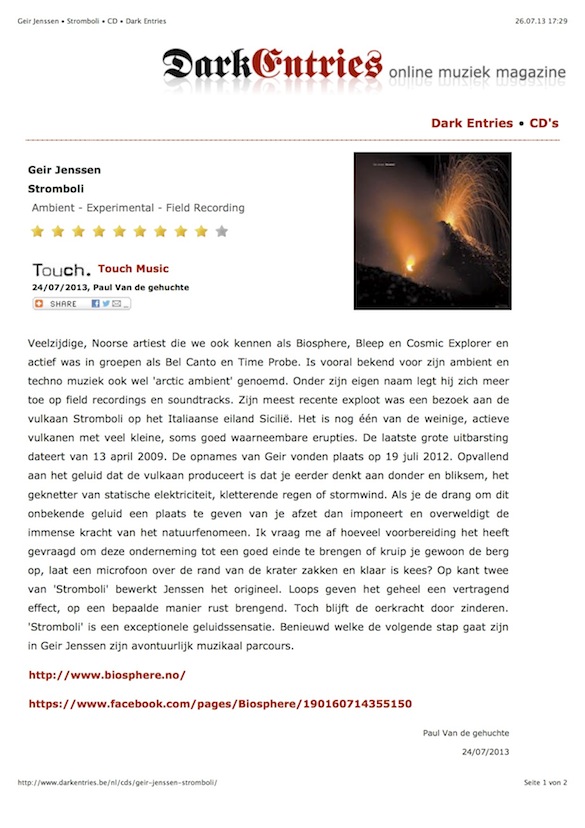
Chain D.L.K. (USA):
Mostly known for having been the harbinger of the so-called ambient-techno or arctic ambient and sonic herald of natural and cosmic energies under the guise of his stage name Biosphere, Norwegian musician Geir Jenssen has a strong passion for climbing. During these endeavours, he often collects sounds and field recording he pour into his records, which are sometimes strictly connected to this hobby: the most known release of this genre has been “Cho Oyu 8201m ‘ Field Recordings from Tibet”, which provided sonic documentary evidence of the climbing without oxygen of Cho Oyu, the sixth highest mountain in the world, he did in September-October 2001. This time he managed to reach the crater edge of Stromboli, an active volcano off the north coast of Sicily, also known as the “Lighthouse of the Mediterranean” as its frequent eruptions (one per hour on average) are easily visible from many points of the self-named island and the surrounding sea and famous in literature as Jules Verne set the final stage and the finish line of “Journey to the Center of the Earth”. Geir climbed it three years after his last major eruption which occurred on April 13th, 2009 with full accouterments (a Canon 5D mkII SLR, a Fostex FR-2LE field memory record and an Audio-Technica AT835ST shotgun microphone) to grab the noises from this red-hot papule of our planet, which sound really striking not only for volcanologists. On the flipside, you’ll also find a version, “Stromboli Dub”, which remarkably differs from the ordinary idea of “dub”, as Geir didn’t add any drum, instrumental or “artificial” sound; he preferred to keep within the lines of original lava murmuring and sudden explosions by extracting a sort of natural rhythmical slow syncopation and emphasizing the “spatial” perspective of the recording by means of slight echo, reverbs and delay.
Blow Up (Italy):
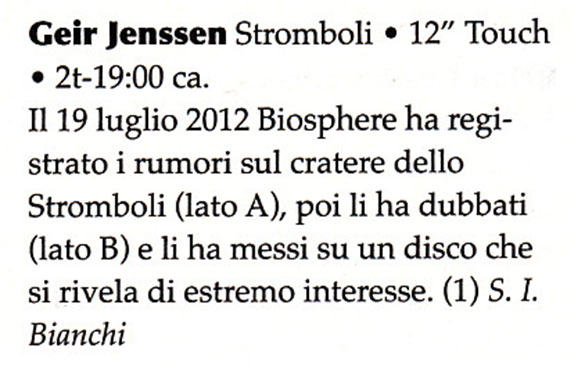
Revue et Corrigé (France):
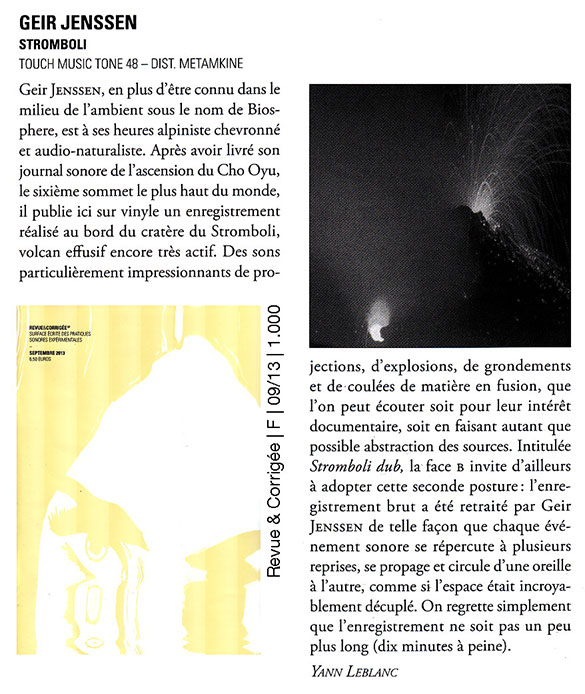
Gonzo Circus (Belgium):
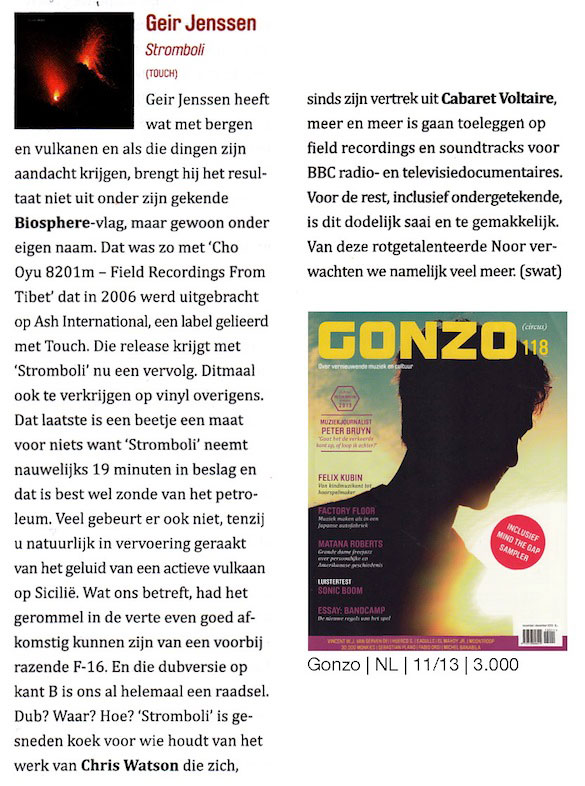
Musique Machine (UK):
Mt. Stromboli, or the Lighthouse of the Mediterranean, is a small volcanic island off of the north coast of Sicily. It has been erupting almost continuously for a several millennium and has regular small eruptions every twenty minutes. Nature has a way of making beautiful music provided you are listening. From recordings from deep space to field recordings of wind in the trees we find stark beauty everywhere as if nature herself was a composer. For most of us the sounds that a volcano makes are completely out of reach and foreign, but now we are lucky, safe at home and far from the heat we can experience them, for Geir Jenssen (aka Biosphere) has brought them to us.
Stromboli is one of those recordings that is caught between the borders of science and music. If it is music than I am tempted to call it Real Rock and Roll, because it is dangerous music, as in Jenssen had to put himself at risk to record it. No matter what we decide to call it its the best record I’ve heard all year! The recording is otherworldly with a bizarre stereo field, startling blasts which are storm-like but too brief feel like they are being sucked away. There are odd gurglings, or is it pressure, or flowing, its hard to tell but the sounds are intense, at times almost like falling jets or perhaps like blow torches exploding. Amidst all of this violence the recording is somehow peaceful and calm, a perfect soundtrack to Lovecraftian landscapes. The whole thing definitely gives you a sense of the massive power of the volcano.
The second track “Stromboli Dub” as suggested by the title is the original recording this time with delay added. While it seems that this would not enhance the recording in anyway it in fact gives you more time to get familiar with every sound and is quite beautiful, tastefully simple. Sonically it reminds me of a time when I was child and got trapped under water in the white wash of a large wave, if that could be slowed down somehow.
This record is a wonderful example of how field recordings can be slightly manipulated to create truly unique music, and of the incredible diversity of nature’s “natural” music.
[Jean-Paul Garnier]
Neural (Italy):
Geir Jenssen – molti lo ricorderanno – è lo sperimentatore che si celava dietro il moniker Biosphere, uno dei principali esponenti dell’ ambient techno, passato poi ad elaborazioni anche maggiormente rarefatte ed astratte. In Stromboli, dieci minuti di field recording registrate nel 2012 a ridosso del cratere omonimo, a 924 metri sul livello del mare, in pieno Mediterraneo, viene documentata l’attività di quella complessa struttura geologica proprio dopo che una eruzione maggiore, nel 2009, aveva riportato all’attenzione dei media un certo risveglio dell’attività effusiva. Un documento audio proveniente da Stromboli – tuttavia – non potrebbe mai essere meramente un’asettica cattura ambientale, troppi sono infatti i riferimenti simbolici a un siffatto “locus” (di natura mitologica, letteraria, di spazio concettuale e/o immaginario). Il comportamento di un vulcano – naturalmente – è soggetto a mutevoli eventi nel corso degli anni, esaurendo infine il suo ciclo di nascita-morte, che coincide poi con la cessazione della capacità eruttiva, ancora lontana per quello che riguarda il caso in questione. Geir Jenssen con il suo Fostex FR-2LE, un microfono Audio-Technica AT835ST e una camera digitale Canon, si è avventurato sulle nere pendici che portano al cratere, riportandone le esplosioni intermittenti e di media energia, dando vita a un interessante e continua effusione sonora, intrisa da scoppi casuali, da emergenze auditive di natura assai organica, da accidentali texture, da mesti sciaguattìi e densi sbrodolamenti: narrazione d’un ipervivido amalgama primigenio, poi manipolato sottilmente nel lato B, versione definita “dub”, ironicamente a ricordare il passato “mainstream” elettronico dell’autore.
Trans:
Many of our readers will remember Geir Jenssen as the experimenter beneath the Biosphere moniker. Considered one of ambient techno music’s main representatives, he has since shifted towards more rarefied and abstract elaborations. Stromboli is a ten-minute field recording captured in 2012 at the volcano of the same name, located in the middle of the Mediterranean Sea, 924 meters above sea level. The work presents the activity of this complex geological structure after a large eruption in 2009, which reawakened media interest in volcanic activity. Documentary audio from Stromboli cannot be an impersonal capture: the symbolic references to this special “locus” are too many (mythological, literary, theoretical and/or imaginary). Jenssen ventured onto the black slopes of the volcano with his Fostex FR-2LE, an Audio-Technica AT835ST microphone and a Canon digital camera. The field recording reports a number of intermittent and medium energy explosions. The work is an interesting and continuous sound flow, filled with casual blasts, organic natural audio emergencies, accidental textures, sad swishes and dense spouts. Jenssen has created a narration of a hypervivid primordial amalgam, one that underwent slight manipulation on the B-side. This was called the “dub” version, an ironic reference to the “mainstream” electronic past of the author.










